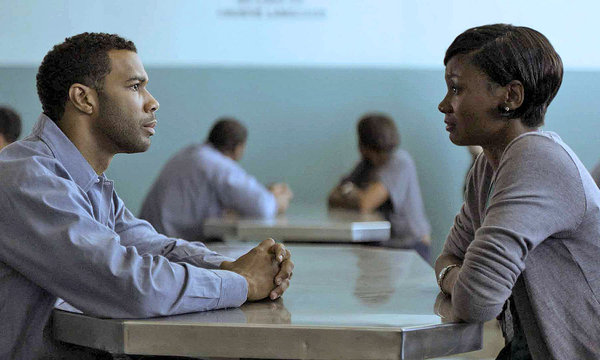Above: Derek (Omari Hardwick) and Ruby (Emayatzy Corinealdi) in Middle Of Nowhere
“Soft power” is a term typically employed in diplomatic circles and it roughly means “the ability to attract and co-opt rather than coerce [or] use force.” However, I think it’s appropriate to use it in connection with filmmaker Ava DuVernay’s body of work thusfar. Both her debut I Will Follow and her recently released Middle of Nowhere her ability to tell a stories using “soft power” is on full display, and it’s one of the reasons she became the first African American woman to win Sundance’s Best Director honors. Resisting the urge for over-the-top drama, she and her collaborator–the brilliant cinematographer Bradford Young–expertly deliver a powerful and satisfying cinematic experience that packs an emotional punch. While the outward action of the film encompasses a lot of stillness, there are a lot of emotions roiling beneath the film’s surface In the case of Middle of Nowhere, still waters do run deep.
This isn’t to say that nothing happens in this film. Hardly. Ruby (Emayatzy Corinealdi) is a woman trying to keep her marriage alive while her husband Derek (Omari Hardwick) serves time in prison. When we meet her, they’re in year four of an eight year sentence. Ruby is stuck between the love she has for her husband and the attraction she has to a handsome bus driver (David Oyelowo). But she’s unsure of whether to let go of the one and head into the future with the other. Legitimately so: There is a chance that Derek could get an early parole for good behavior. Unfortunately, a prison sentence changes everyone–the prisoner and his or her family–something that Ruby is reluctant to admit. What she ultimately decides, well, that’s the story of the film.
The “soft power” thing I referenced at the beginning is something that’s rare in films these days. That is, what you have in “Middle of Nowhere” is a deep dive into a black woman’s internal story. Yes, there are these outside circumstances that impact her. But the film is really an exploration of how she deals with them, how she wrestles with the inner turmoil that these circumstances cause. And though worn down, Ruby remains a fighter: One of the best scenes is when she barges into her husband’s lawyer’s office to plead for her to represent him at his parole hearing. It’s not ballsy: Rather, you know immediately that, once more, she’s got to put her pride aside and almost beg the lawyer to stay on the case.
Film, of course, if visual. Cinematographer Young’s camera work uses closeups, blurred lenses and flashback sequences that are more like daydreams that make it clear the powerful tug the past has on Ruby and the memories that anchor her to her life with Derek before his arrest.
And, as with any person with a complicated past, we don’t get to know Ruby’s story fully until the end, until we’ve spent time with her. It was a satisfying reveal.
DuVernay is to be commended. She’s leading the charge of 21st century black filmmakers–including her fellow 2012 Sundance directors such as Terence Nance–who understand that excellence in filmmaking doesn’t have to come at the expense of audience accessibility. It’s not necessary to pander to lowest common denominator tactics.
Bottom line: If you haven’t seen Middle of Nowhere yet, do yourself a favor and get to a theater in your area.
Additional links:

